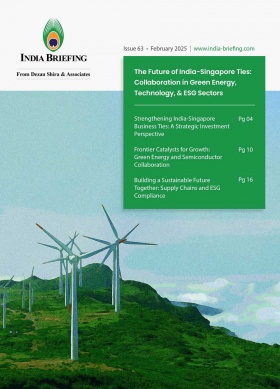India’s Manufacturing Sector Poised for Growth Amid Global Trade Shifts: Report
India’s manufacturing segment continues to register an uptake in production activities and market demands, even as global economies reel under the tariff and trade disputes. The domestic market has also made noticeable strides in enhancing its manufacturing and trade competitiveness, making it more appealing for foreign investors.
India has made progress in enhancing the appeal of its manufacturing sector to global investors, according to a study published by S&P Global on May 19, 2025. The report, titled India Forward: Transformative Perspectives, outlines how ongoing changes in international trade dynamics may support India’s long-term industrial growth.
According to S&P Global, a US-based market intelligence firm, India’s relatively moderate reliance on external trade provides some buffer against the ongoing fluctuations in global trade and tariff policies. The company, however, makes a note that the country remains exposed to the effects of increasing trade protectionism.
The manufacturing sector contributes approximately 17.2 percent to India’s real GDP as against the central government’s target of 25 percent. In recent years, India has introduced targeted policy measures aimed at enhancing domestic manufacturing capacity and reinforcing India’s role in global supply chains.
Exclusive 2025 Tracker: Find Out Where India’s Manufacturing Is Headed Next
Opportunities for India’s manufacturing sector amid global trade realignment
India is currently navigating challenges in the global trade environment, including increased tariffs on its exports to the United States—its largest export market. Broader uncertainties in international trade and financial markets may pose short-term risks to India’s economic growth, with private sector investment potentially affected by ongoing policy unpredictability.
Despite these near-term pressures, the S&P report suggests that rising global trade protectionism could lead to greater diversification of supply chains, presenting a longer-term opportunity for India. The possibility of elevated US tariffs on exports from other Asian economies—such as China, Vietnam, Taiwan, Thailand, and Bangladesh—could create favorable conditions for India to expand its manufacturing base and enhance its presence in global export markets.
India has taken a proactive and strategic stance to safeguard its export competitiveness. On April 2, 2025, US President Donald Trump announced a revised tariff structure, introducing a baseline 10 percent duty on all imports starting April 5, along with higher “reciprocal” tariffs for dozens of countries, including India, facing tariffs as high as 26 percent.
Amid this shifting trade environment, India has intensified its engagement in bilateral and multilateral trade negotiations. Notably, on May 6, 2025, India and the UK finalized a long-pending Free Trade Agreement (FTA) after more than three years of negotiations. Additionally, India concluded the 11th round of talks with the European Union on May 18, 2025, regarding their proposed FTA.
Policy intervention spurs export boom in India’s key sectors
India’s share in global manufacturing exports remains modest, reaching only 1.8 percent in 2024. In contrast, the country’s share in global services exports rose from 2.9 percent in 2014 to 4.3 percent in 2024, reflecting stronger performance in that segment.
The central government has introduced a series of targeted initiatives, such as the Production Linked Incentive (PLI) scheme, aimed at expanding domestic production and improving supply chain integration to boost exports in sectors such as electronics, pharmaceuticals, and automobiles. A notable outcome is the surge in mobile phone exports from India—from virtually zero in 2016 to US$20.4 billion in 2024, including a 44 percent year-on-year increase—following Apple’s decision to shift part of its production from China to India.
India’s robust PMI score in FY 2024-25
Data from the monthly HSBC Purchasing Managers’ Index (PMI), compiled by S&P Global Market Intelligence, indicates that India’s manufacturing sector has demonstrated resilience in the face of global economic challenges. Since 2024, India’s manufacturing PMI scores have consistently outperformed global averages, supported by strong demand, increased hiring, and inventory accumulation.
|
Global Manufacturing PMI Output Index |
||||||
|
|
India |
US |
Eurozone |
UK |
China |
Japan |
|
April 2024 |
63.0 |
51.1 |
47.3 |
49.4 |
53.1 |
47.8 |
|
May 2024 |
61.1 |
53.0 |
49.3 |
53.4 |
54.3 |
49.9 |
|
June 2024 |
61.9 |
52.1 |
46.1 |
53.3 |
54.6 |
50.4 |
|
July 2024 |
61.7 |
50.5 |
45.6 |
54.9 |
50.2 |
49.7 |
|
August 2024 |
60.3 |
48.2 |
45.8 |
54.4 |
50.7 |
51.3 |
|
September 2024 |
59.8 |
47.9 |
44.9 |
53.6 |
50.2 |
49.7 |
|
October 2024 |
60.4 |
49.2 |
45.8 |
50.3 |
51.8 |
49.4 |
|
November 2024 |
59.1 |
47.9 |
45.1 |
48.3 |
53.2 |
49.2 |
|
December 2024 |
59.0 |
47.7 |
44.3 |
45.9 |
50.5 |
49.4 |
|
January 2025 |
60.1 |
51.8 |
47.1 |
49.2 |
51.2 |
47.3 |
|
February 2025 |
58.1 |
54.5 |
48.9 |
47.3 |
51.6 |
48.4 |
|
March 2025 |
61.7 |
48.6 |
50.5 |
45.3 |
51.8 |
46.6 |
Source: S&P Global Market Intelligence
In 2024, India’s manufacturing PMI consistently remained above the neutral threshold of 50, suggesting ongoing expansion in employment. This upward trend reflects increased hiring activity by manufacturers responding to stronger production demand and healthy order books.
The report, however, notes that rising input costs at times have limited the pace of recruitment. Overall, job creation has been moderate in comparison to output and sales growth, as many firms have focused on maximizing existing capacity and operational efficiency.
Long-term economic gains from supply chain revision
Scenario analysis from a different S&P Global report indicates that although the threat emerging from the US tariffs and ongoing global policy uncertainty may pose short-term challenges, the broader shift toward manufacturing reshoring and regionalized trade could benefit India over the long term. The trade trends have the potential to raise India’s real GDP by approximately 1.3 percentage points above baseline projections by the end of fiscal year 2034–35.
Furthermore, India’s real GDP growth is expected to average 5.7 percent annually over the next decade. As global firms seek alternative manufacturing hubs, India is increasingly viewed as an attractive destination due to its cost advantages and expanding industrial base. The report suggests that enhancements in logistics infrastructure, labor market flexibility, and access to financial resources would improve India’s business environment for manufacturing, leading to higher output, increased employment, and stronger overall economic performance.
According to a long-term analysis of S&P Global Market Intelligence’s Strategic Opportunity Index (SOI®), India has made measurable progress in improving its market competitiveness and attracting greater investment into its manufacturing sector.
The S&P Global report, in its comparison of data across the G20 economies over the past decade, notes that India has shown substantial momentum in several areas. Notably, the domestic industry-focused policies’ favorability indicates a strong shift toward a more supportive regulatory environment.
Outlook
As global trade patterns continue to evolve and tariff policies become increasingly complex, India has an opportunity to position itself for sustained manufacturing growth. By embracing strategies such as increased local sourcing, greater regional integration, and proximity to end-consumer markets, the country can attract higher levels of investment. These efforts are likely to enhance India’s technological capabilities, boost competitiveness in manufacturing, and generate a greater number of skilled employment opportunities within the sector.
About Us
India Briefing is one of five regional publications under the Asia Briefing brand. It is supported by Dezan Shira & Associates, a pan-Asia, multi-disciplinary professional services firm that assists foreign investors throughout Asia, including through offices in Delhi, Mumbai, and Bengaluru in India. Dezan Shira & Associates also maintains offices or has alliance partners assisting foreign investors in China, Hong Kong SAR, Vietnam, Indonesia, Singapore, Malaysia, Mongolia, Dubai (UAE), Japan, South Korea, Nepal, The Philippines, Sri Lanka, Thailand, Italy, Germany, Bangladesh, Australia, United States, and United Kingdom and Ireland.
For a complimentary subscription to India Briefing’s content products, please click here. For support with establishing a business in India or for assistance in analyzing and entering markets, please contact the firm at india@dezshira.com or visit our website at www.dezshira.com.
- Previous Article 印巴边境紧张局势下的印度经济脉动
- Next Article FTAs and FDI Fuel Expansion in India’s Luxury Car Segment








